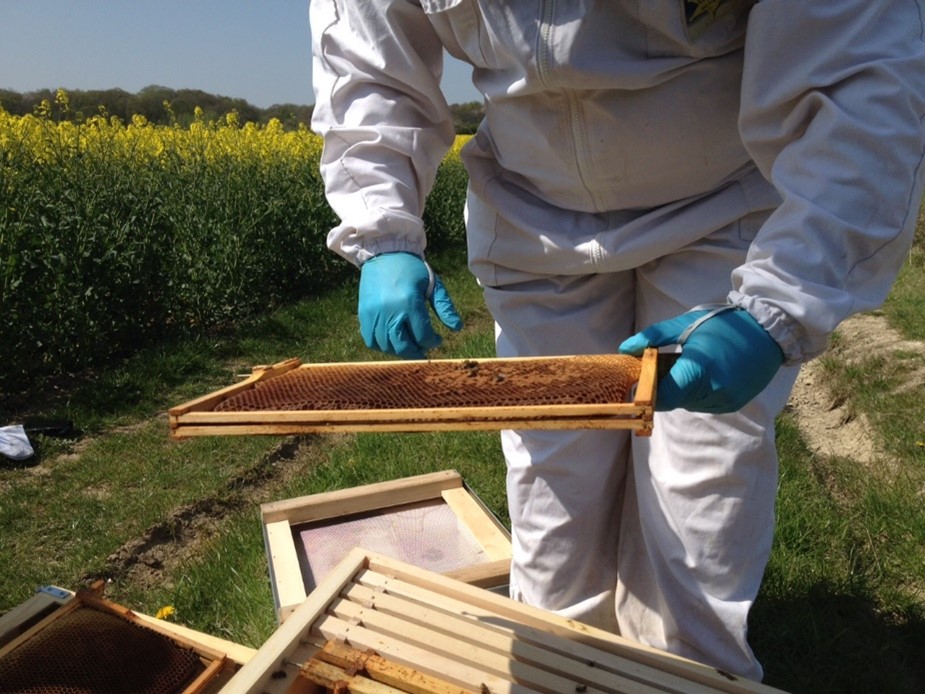Working in partnership with UK beekeepers, the National Honey Monitoring Scheme (NHMS) aims to use honeybees to monitor long-term changes in the condition and health of the UK countryside. However, we need the help of beekeepers for the scheme to work.
Our overall aim
Both honeybees and wild bees have suffered declines in recent years. These are thought to be linked to agricultural intensification, including pesticide use and loss of habitats/ floral resources, as well as the emergence of new diseases and climate change. Their sensitivity to the way we manage land in the UK has long been a cause for concern. However, this same sensitivity makes honeybees ideal for monitoring changes in the countryside over time and at a national scale - due to the large distances over which honeybees forage. The honey collected by honeybees contains incredibly valuable information on the state of the landscape the bees live in and environmental pressures they are exposed to.
The National Honey Monitoring Scheme
We work with beekeepers from all over the UK to analyse their honey samples. We identify which plants their bees have been visiting. Over time we can use this to build up a picture of long-term changes in the condition and health of the countryside
What do we do?
With the help of beekeepers we collect honey samples from across the UK and have been doing so since 2018. These samples are analysed using advanced DNA barcoding techniques to identify the species of plant pollen present. This tells us what bees are feeding on in different parts of the country and at different times of year. This information helps us identify possible threats to the floral resources of pollinating insects.
All of the honey samples beekeepers send us will be carefully archived to enable future investigations of other threats to bees, including pesticide residues and the presence of certain bee diseases.
If you are a beekeeper and register to take part in the monitoring scheme we will also ask you to provide a few basic facts about your bee hives to help us put our results into context. This will include:
-
How much honey is the hive or apiary producing?
-
Have you had any hive deaths?
-
Have you had any diseases, have you treated them for these diseases and did this have any effect?
Pollen data
Fully anonymised data showing regional differences in flowers visited by bees will be made available to the beekeeper's website account. This will include information on what your bees have been feeding on based on a DNA analysis of the pollen within the honey you sent, as well as what habitats – including crops important for foraging bees – surround your hive location.
Identification of plant species present will be determined by matching of sequence data to a database of all publicly available plant DNA sequences. Identification will be to the closest match and cannot be used for certification purposes.
Also provided is a breakdown of crops and other habitats surrounding your apiary, based on analysis of satellite images.
All the data we collect will be totally confidential, but this information will help us understand how environmental factors affect floral resources. Further, in creating a long-term archive of honey (and potentially other hive products such as pollen stores) we hope to support future research into beekeeping.
Pesticide data
A subset of honey samples are tested for the presence of a panel of ~90 pesticide residues, to understand what honey bees are exposed to whilst foraging and the degree to which these exposures accumulate in honey.
Honeybees and wild bees are particularly susceptible to exposure to pesticide use in agriculture and other situations. Pesticides are found throughout the countryside and for many bees feeding on flowering crops or on wildflowers next to agricultural fields is commonplace. This makes them particularly susceptible to exposure to pesticides used on these crops or the wildflowers near them. While many insects may be exposed to pesticides, they can be a particular risk for bees as not just the adult workers but also the larvae, queen and nurse bees feed on contaminated pollen and nectar.

Pesticide regulation is strict in the UK. However, as good as it may be, it has been repeatedly seen that risks resulting from pesticide use can by very hard to predict in real world agricultural systems. Bees forage in unpredictable ways, and often over very large areas, with the result that they can concentrate relative low pesticide residues seen at landscape scales in their hives. This means that there may by unexpected risks to bees once pesticides become widely used. In the past there has been only a limited mechanism available to monitor these risks from pesticides.
In 2020 Defra (Department of Fisheries, Food and Rural Affairs) commissioned the UK Centre for Ecology & Hydrology (UKCEH) to undertake pilot work monitoring pesticide residues in honey collected under the NHMS.
This was intended to support the Outcome Indicator Framework - a comprehensive set of indicators describing environmental change that relates to the 10 goals within the 25 Year Environment Plan which sets out what the government will do to improve the environment within a generation. The framework contains 66 indicators, arranged into 10 broad themes. Samples collected through the NHMS provide an opportunity for beekeepers to directly contribute to the development of the H4: Exposure and adverse effects of chemicals on wildlife in the environment.
This indicator tracks changes in the exposure of wildlife to chemicals in the environment over time and considers the potential risks to wildlife from chemicals in terrestrial, freshwater and marine ecosystems.
Funding
The Honey Monitoring Scheme is supported by national capability funding from UKCEH under the AgZero+ programme. National capability funding is provided to UKCEH directly from the Government to support long-term, large-scale monitoring of environmental change in the UK. UKCEH is an independent, not for profit research organisation.
